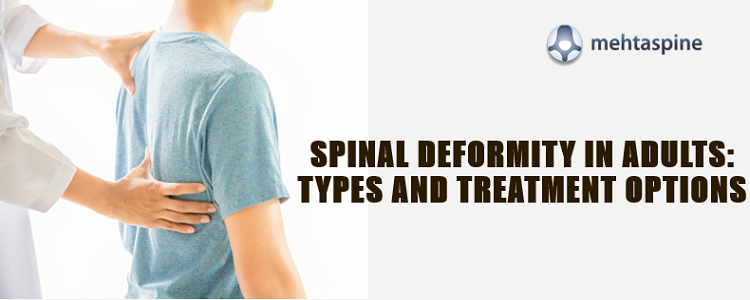Spinal Deformity in Adults: Types and Treatment Options
Human Spine is a strong and stable structure made up of building blocks of bone called vertebrae. The spine protects the spinal cord and also serves as a pillar in the back supporting the body weight. The three natural curves of the spine (as seen from the side) bears a large amount of stress and aligns the centre of gravity by properly distributing the body weight.
A spinal deformity happens when the human spine gradually loses its healthy shape and structure, manifesting as back pain and structural deformity. While non-surgical options like physical therapy, exercise, bracing, injections sometime help, adult spinal deformities when progress may need spinal deformity surgery corrections to cure the deformity.
Types of Adult Spinal Deformity:
Spinal deformities are caused by abnormal bending, twisting or rotation of the spine at various regions in the back. Spinal deformities can occur both in children & adults and can be divided into two types, in general:
1. Sagittal Imbalance:
When the natural curve in the upper spine (called Kyphosis) departs from its healthy angle, the spine may experience a sagittal imbalance. Spinal conditions that cause this sagittal imbalance include flat-back syndrome chin-on-chest syndrome, hyperkyphosis, and ankylosing spondylitis. In severe cases, these sagittal imbalance causing condition can result in problems like fatigue, pain, stooping, and difficult looking straight. In advanced and complicated cases, it can also result in compression of the critical organ in the upper body (heart, lungs, etc.) making spinal deformity surgery an inevitable option for spine specialists.
2. Scoliosis:
While a healthy human spine looks straight from the behind, in few conditions it can cause it to stray away from the straight line by more than 10 degrees resulting in the most common spinal deformity which can worsen over time: Scoliosis. Adolescent idiopathic scoliosis, neuromuscular imbalances, degenerative scoliosis, spine tumours, and congenital deformities are some of the few causes of this spinal deformity.
Adult degenerative scoliosis caused due to degeneration of the spine is one of the most common causes of spinal deformity in adults. Though the spinal deformities caused by scoliosis due to trauma or spinal tumours are less common, they are as debilitating as any other spinal deformity suffered by the adults.
Treatment Options for Adult Spinal Deformities:
Treatment for adult spinal deformities is tailored based on the age, medical history and severity of the deformity suffered. Patients with spinal deformities are offered non-surgical treatment options like physical therapy, exercise, injections. And only when these options fail to cut-down the progression and treat the deformity, surgical treatment are recommended by the spine specialist.
Surgical treatment options are also considered when the curvature is so severe that it begins to interfere with the function of organs and is still under the progression. Mr Jwalant S Mehta has performed hundreds of adult spinal deformity corrections in the U.K to cut down the curve and stabilize the spine.
Adult Spinal Deformity Surgery in the U.K:
In general, surgery for spinal deformities is considered if the kyphosis (upper spine curve) is more than 70 degrees and scoliosis (lateral curve) is greater than 45 degrees. Curves of this severity over time can result in twisting and rotating the spine interfering with the critical organ function, making surgery an only effective option.
Surgery for the spinal deformity involves both correction and re-stabilization of the spine. Correction involves the alignment of the spine to its natural shape using screws, plates, and implants. The aligned spine is fused by using bone grafts to encourage permanent bone fusion for a stable spine.
Surgical correction of the spinal deformity cuts down the deformity and stops the curve from progressing. Spinal deformity surgery reduces pain, improves posture, relieves the organs from the pressure caused the deformity.


